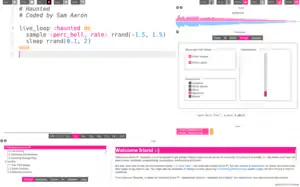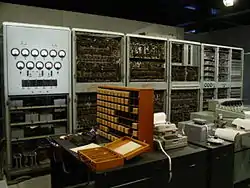Sonic Pi
Sonic Pi is a live coding environment based on Ruby, originally designed to support both computing and music lessons in schools, developed by Sam Aaron in the University of Cambridge Computer Laboratory[1] in collaboration with Raspberry Pi Foundation.[2][3]
 Screenshot of Sonic Pi | |
| Developer(s) | Sam Aaron and others |
|---|---|
| Initial release | 2012 |
| Stable release | 3.3.1
/ 1 February 2021 |
| Repository | |
| Written in | Ruby, Erlang, Clojure, C++, and Qt |
| Operating system | Linux, macOS, Windows, Raspberry Pi OS |
| Type | Live coding environment |
| License | MIT License |
| Website | sonic-pi |
Uses

Sam Aaron, creator of Sonic Pi, demonstrating the program
Thanks to its use of the SuperCollider synthesis engine and accurate timing model,[4] it is also used for live coding and other forms of algorithmic music performance and production, including at algoraves. Its research and development has been supported by Nesta, via the Sonic PI: Live & Coding project.[5]
See also
Further reading
- Aaron, Samuel; Blackwell, Alan F.; Burnard, Pamela (2016). "The development of Sonic Pi and its use in educational partnerships: Co-creating pedagogies for learning computer programming". Journal of Music, Technology & Education. 9 (1): 75–94. doi:10.1386/jmte.9.1.75_1. Retrieved 11 December 2019.
- Aaron, Sam. (2016). "Sonic Pi–performance in education, technology and art". International Journal of Performance Arts and Digital Media. 12 (2): 17–178. doi:10.1080/14794713.2016.1227593.
- Sinclair, Arabella (2014). "Educational Programming Languages: The Motivation to Learn with Sonic Pi" (PDF). PPIG: 10. Retrieved 11 December 2019.
- Aaron, Samuel; Blackwell, Alan F. (2013). "From sonic Pi to overtone: creative musical experiences with domain-specific and functional languages". Proceedings of the First ACM SIGPLAN Workshop on Functional Art, Music, Modeling & Design. ACM: 35–46. doi:10.1145/2505341.2505346. Retrieved 11 December 2019.
- Aaron, Samuel; Blackwell, Alan F.; Hoadley, Richard (2013). "A principled approach to developing new languages for live coding". Proceedings of the First ACM SIGPLAN Workshop on Functional Art, Music, Modeling & Design: 35–46. doi:10.1145/2505341.2505346. Retrieved 11 December 2019.
References
- "DROPS - Collaboration and learning through live coding (Dagstuhl Seminar 13382)". drops.dagstuhl.de. Retrieved 2015-05-02.
- Cellan-Jones, Rory. "Baked in Britain, the millionth Raspberry Pi". BBC News. Retrieved 2015-05-02.
- "Making music with Raspberry Pi - CBBC Newsround". www.bbc.co.uk. Retrieved 2015-05-02.
- Aaron, Samuel; Orchard, Dominic; Blackwell, Alan F. (2014). "Temporal semantics for a live coding language" (PDF). Proceedings of the 2nd ACM SIGPLAN international workshop on Functional art, music, modeling & design - FARM '14. FARM '14. ACM. pp. 37–47. doi:10.1145/2633638.2633648. ISBN 978-1-4503-3039-8.
- "Sonic Pi - The Live Coding Music Synth for Everyone". SONIC PI. Retrieved 2019-10-05.
This article is issued from Wikipedia. The text is licensed under Creative Commons - Attribution - Sharealike. Additional terms may apply for the media files.

%252C_June_13%252C_2011.jpg.webp)